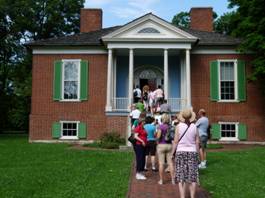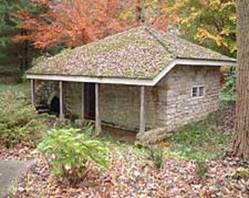Locations | Resources | About | Materials
4. Farmington Historic Plantation


3033 Bardstown Road
Louisville, KY 40205 (southeast quadrant of the city)
Telephone: (502) 452-9920; Fax: (502) 456-1976
For additional details about admission, school visits, and educational materials, visit the Farmington Historic Plantation website at http://www.historichomes.org/farmington
Farmington, the center of a 550-acre hemp plantation, was built for John and Lucy Speed during 1815 and 1816. The Federal-style house has an ambitious and unusual plan identified in the original building contract as the work of Paul Skidmore, (? – 1817), a Kentucky entrepreneur about whom little is known. Skidmore was clearly influenced by the architectural work of Thomas Jefferson. With two octagonal rooms imbedded in the center of the house, Farmington’s plan is very similar to one produced by Jefferson for an unidentified residence.It is likely that the design reflects Lucy Speed’s ambitions for a sophisticated house acknowledging her roots in Jefferson’s Virginia. Her grandfather, Dr. Thomas Walker, served as Thomas Jefferson’s guardian and her uncle-by-marriage, George Divers, lived at another house called Farmington. Divers’ house in Charlottesville, Virginia, for which Louisville’s Farmington was named, had a Jefferson-designed octagonal addition. Lucy had almost certainly seen the house on a trip back to Virginia in 1806.
Farmington, opened as a museum in 1959, has gone through several different interpretations. Its current presentation is based on an extensive reinterpretation and restoration completed in 2002 that strives to reflect the life of the Speed family during the 1816-1841 period. The precise original function of many rooms in the house remains uncertain. “Mrs. Speed’s room,” the “parlor” and the “dining room” are all mentioned in the original building contract. The designations of the other rooms are based on knowledge of houses of the period and clues revealed in a detailed probate inventory prepared at the time of John Speed’s death in 1840.
